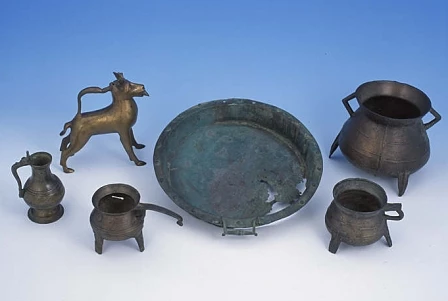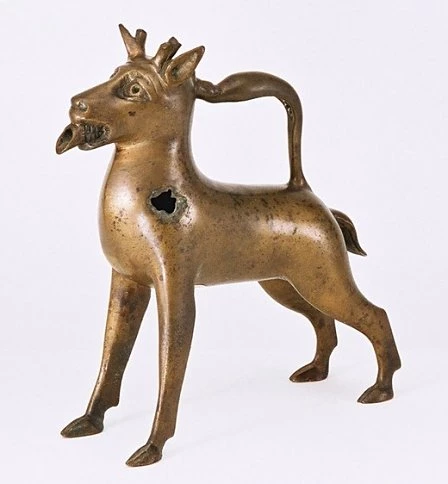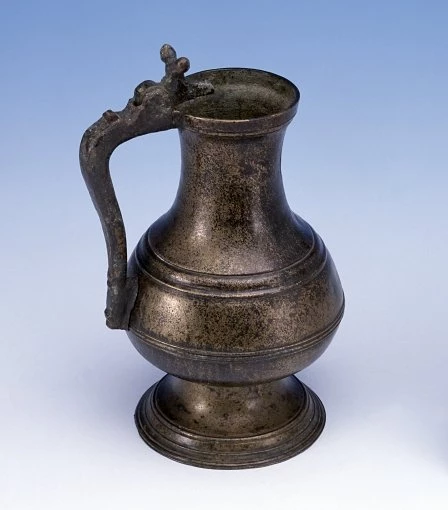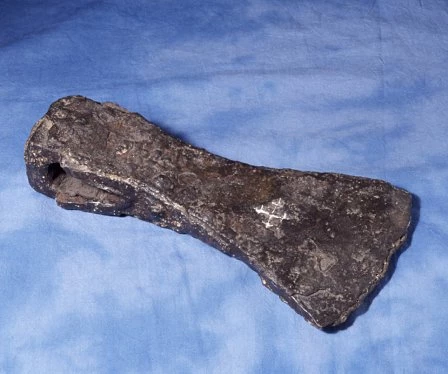Remarkable treasures unearthed by workman
Part of the Cwm Nant Col Hoard, including the major copper-alloy pieces.
Late 13th or early 14th-century aquamanile in the shape of a stag. 26cm (10.2 inches) tall.
15th-century copper alloy ewer. 17.5cm (6.9 inches) tall.
Copper-alloy tray or dish. 39.5cm (15.5 inches) in diameter.
Woodman's iron axe with a maker's mark in the form of a cross. 27cm (10.6 inches) long.
In 1918, a remarkable hoard of treasure was discovered by a workman mining for manganeese near Llanbedr in Gwynedd.
The hoard had been concealed in a cavity beneath a large stone on rough ground on the south side of Cwm Nant Col.
What makes the hoard so interesting is not just the wide range of objects - from a fine vessel (known as an aquamanile, used for pouring water) in the shape of a stag, to bronze skillets, a smaller water jug (known as a ewer) - but also their date. Most metalwork hoards found in Wales tend to be prehistoric, but this one was late medieval.
Extraordinary craftsmanship
One of the earliest items in the hoard is the aquamanile, dating from the late 13th to early 14th-century. Made of copper-alloy, it has a hinged lid on top of the stag's head to allow the hollow vessel to be filled with water. A short pouring spout extends from its mouth. It has been cast in a single piece, exhibiting extraordinary skill by its maker. It would have been used for ceremonial hand-washing either in a church or monastery, or at the feast table. Although the stag has lost his antlers he remains a fine example of this type of vessel.
The copper-alloy ewer is identical to one found at Strata Florida Abbey. The form and alloy composition of both of these vessels suggest parallels with 15th-century examples produced in pewter.
One copper-alloy cauldron, two skillets and tray from the hoard had a more mundane purpose, being typical items from a 15th-century kitchen - albeit a relatively wealthy one. The other items in the hoard were made of iron and included an axe and fragments from firedogs.
Scientific analysis
While we have learnt much from the style of these objects, we know much more about them as a result of scientific analysis.
The alloy composition of the aquamanile is higher in lead than zinc and tin, suggesting that it was made in Germany. The ewer may have been produced in France or England. The cauldron and skillets were made of a leaded bronze whose proportions of tin, zinc and antimony pointed to manufacture during the 14th- or 15th-century.
The diverse range of objects in the hoard, and their worn state, suggests that they had been gathered as scrap metal by a travelling tinker, probably in the early 16th-century. Why did he bury his goods on a remote hillside?
The answer may relate to the poor supply of copper to Britain in the last half of the 16th-century, and the laws that controlled the trade in bronze and brass. These laws were also intended to prevent the export of scrap metal that could be used to make cannon.
The tinker may therefore have been concealing a hoard that he had collected illegally and which might have been subject to confiscation. Alternatively, had he bought the hoard legally at a market, he may have concealed it temporarily while he tried to find more items to go with it.
As for where he might have hoped to sell his scrap, it is possible that he was heading towards Chester, or via Welshpool to the West Midlands, one of the most active areas of metal manufacturing at this time.
Background Reading
'The Nant Col Hoard of medieval metalware' by J. M. Lewis, R. Brownsword, E. E. H. Pitt and T. Ciuffini. In Archaeologia Cambrensis vol. 136, p156-70 (1987).




